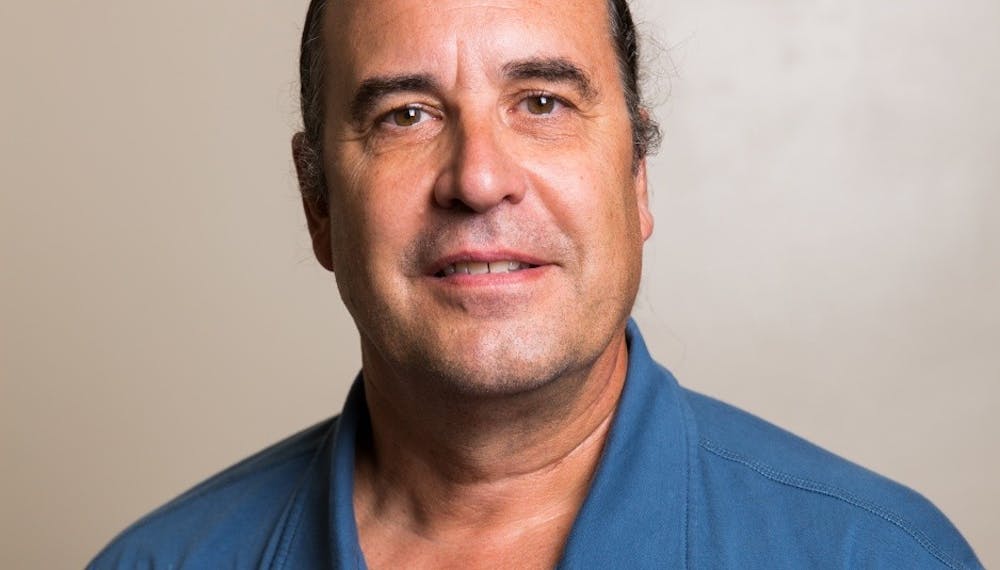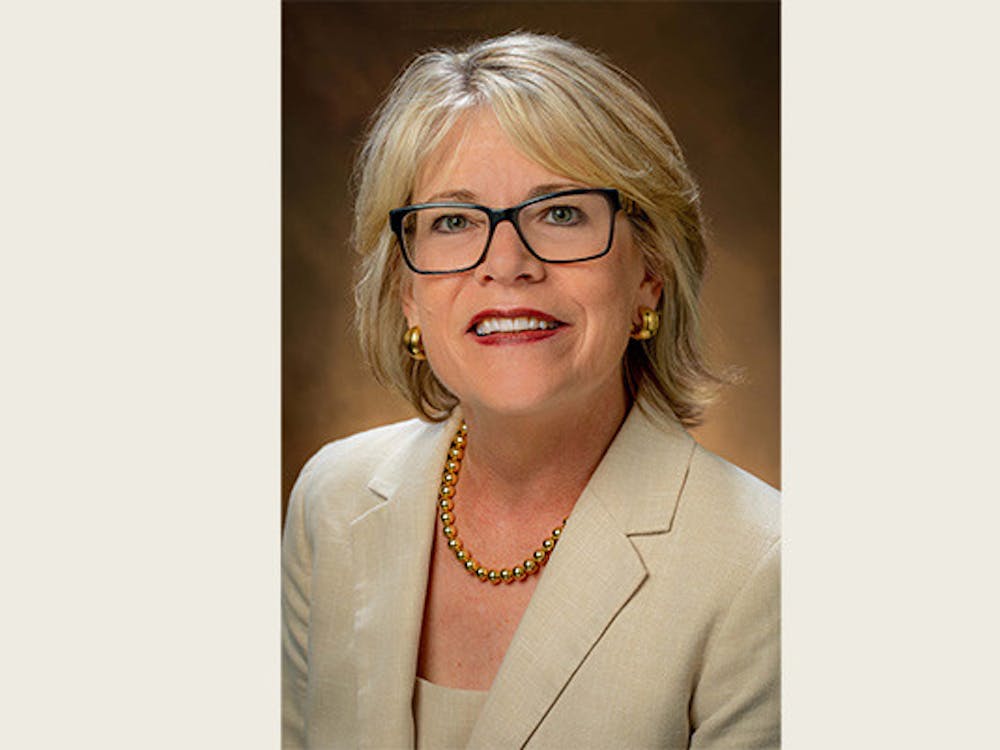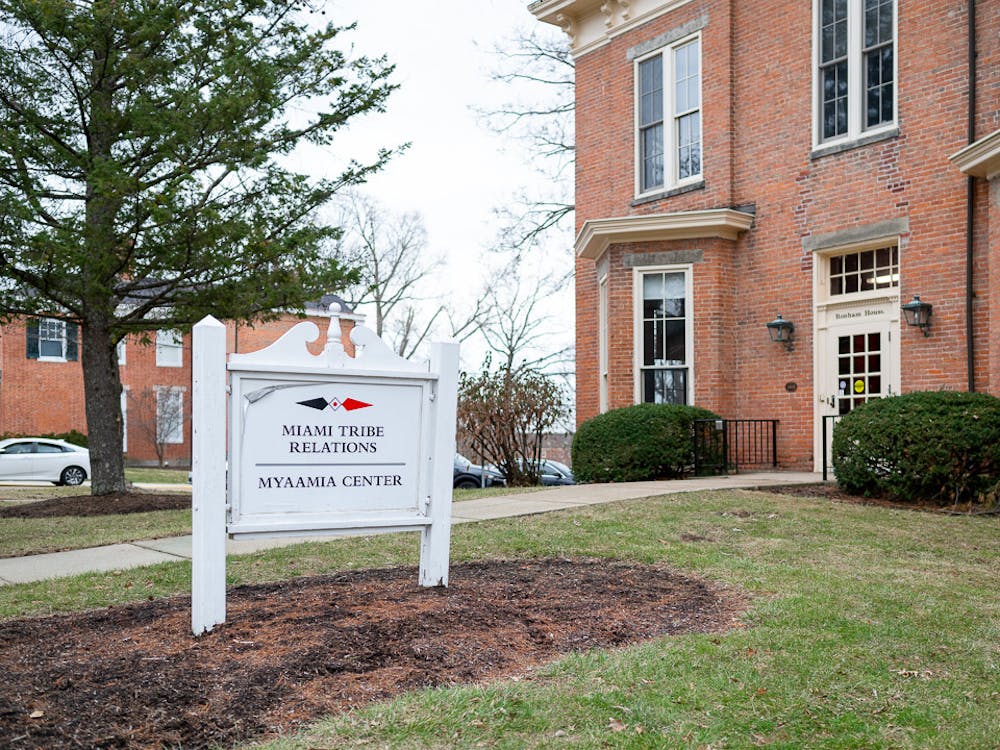[et_pb_section admin_label="section"] [et_pb_row admin_label="row"] [et_pb_column type="4_4"] [et_pb_text admin_label="Text"] Years ago, Daryl Baldwin was rummaging through a box of papers handed down to him by his father. Near the bottom, he discovered writing in Myaamia, the native language of the Miami Native American tribe.
He was struck with curiosity, wondering what the words meant. At the time, nobody could read it. The last speakers of the language died sometime during the mid-twentieth century.
So, he decided to teach himself the language, launching him on a lifelong passion that led from eight years in college to earning a MacArthur genius grant this year.
Given out over five years, the $625,000 grant comes with no strings attached.
Baldwin was walking through Phillips Hall, an academic building on campus, when he got the news -- he saw an unknown number from Chicago appear on his phone screen. While he doesn't normally answer calls from numbers he doesn't recognize, he decided to take this one in an empty stairwell.
Members of the selection committee informed him he won a prestigious award that only 23 people received this year, including a theoretical computer scientist, a playwright and a long-form journalist. And he was receiving $625,000.
"It's kind of a numbing thing to have somebody call and award you a half a million dollars, no strings attached," Baldwin said. "I have no idea who did it or how it even happened."
Sitting across from me at a smooth wooden table in his office in the Myaamia Center at Miami, he prepares to tell me his story. The Miami tribal flag hangs outside his office door, and his children smile out from a picture frame perched on his desk. Teepaalilaani noohsa (I love you father) is written across the frame in purple stick-on letters.
He is soft-spoken and peers from behind glasses, his long grey and dark brown hair tucked into a neat braid. He begins.
"It was a life's passion," Baldwin said.
A Journey Driven by Curiosity
Baldwin made the discovery of his grandfather's papers around 1990, when he was in his late twenties. He teamed up with David Costa, a graduate student from University of California Berkeley who was interested in reconstructing the language. The two met at a gathering in Muncie, Indiana and launched the project.
Enjoy what you're reading?
Signup for our newsletter
Baldwin was born in Toledo, within the historical homelands of the Miami tribe. He started college at 27 at Hocking College and transferred to the University of Montana after two years, enrolling in the linguistics program.
During this time, Baldwin juggled supporting a family while being a non-traditional college student.
"I paid school loans until I was in my 50s, "Baldwin said. "We knew wanted to make change and we wanted to reach for something greater than maybe what was currently available and that took sacrifice."
He received his bachelor degree in wildlife biology and a graduate degree in arts with an emphasis in Native American linguistics. He just finished paying off his loans.
The time he dedicated to learning the language was immense. Thousands of hours were spent pouring over historical documents, extracting meaning from documents dating back as far as the 1700s.
Hundreds of photocopies of the documents sit on his desk. Myaamia words and their descriptions in English are scrawled across a thick stack of pages.
He taught himself the language and learned it alongside his family. Baldwin has four children, ranging in age from 17 to 27.
Baldwin's younger children started learning the language around two or three, when he was first constructing it. The two younger children's first words were in Myaamia.
He also learned the language with his wife, Karen Baldwin. She helped make many of the learning materials when she home schooled their children. For example, his family made a body parts game out of felt, matching the felt body part with the name in Myaamia.
Baldwin's wife is not a citizen of the federally recognized Miami tribe of Oklahoma and does not have a vote in the tribal community, but she learned the language alongside her husband, helping teach it to her children. She is a part of the Myaamia community, even if she wasn't born into it.
"Culture is a funny thing," Baldwin said. "You get immersed in it long enough and it feels like a part of you no matter your background and heritage."
Baldwin officially came to Miami in 2001, when he was asked to be the director of what was then called the Myaamia project. He visited classes and continued his research, furthering the project's mission of revitalizing the Miami tribe's language and culture.
He was the only staff on the project when he started as the founding director. He had a tiny office on the third floor of King Library.
"I think it used to be a closet," he said with chuckle. "But it had a window."
Now, the Myaamia project has become the Myaamia Center in the Stanton-Bonham house in the heart of campus. Seven Myaamia staff members reside behind the brick facade of the nearly 150-year old house.
A Community of People
Colleen Scheible, who has worked as a student administrator with Baldwin for three years, said his humility showed through the day after he received the MacArthur grant. They had a small lunch for him in the office, but he didn't treat it as different from any other day.
"When he won that award it was like just another day," Scheible said. "Yeah he won an award but it was just like 'carry on.'"
Baldwin doesn't sit easily in the spotlight. He always emphasizes the community effort surrounding the revitalization of the Myaamia language and culture, rather than his own achievements.
"What exists today came as the efforts of many. I don't put myself out there as being the cause of what we have," Baldwin said. "I think a lot of individuals have invested in this effort and that's why we have what we have today."
Those individuals include David Costa, who initially teamed up with Baldwin when he started his research. Or Bobbe Burke, the liasion between the tribe and the university, whose office sits next to Baldwin's. Or Julie Olds, the Miami Tribe's Cultural Resource Officer, who is responsible for initiating the revitalization of the culture.
And yet no one can deny the work he has done to revitalize the language and culture of the Myaamia tribe.
"The tribe is his life. He's so dedicated to it," Scheible said. "He really pours his heart and soul into everything he does for the tribe."
The language is his bridge to his tribe of over 4,400 citizens, connecting him to his past and his future.
No one spoke the language over 25 years ago. Now, new generations of tribal students are becoming proficient in the language, with several hundred novice speakers in existence today.
Filling the Void
Now, those tribal students stand in a circle on a grassy quad at Miami, lacrosse sticks slung over their shoulders -- a unique day of class outside. All 32 students are taking this class as one of their Miami Tribe Heritage classes, a program for tribal students that requires three years of coursework and one year of independent study in the Myaamia language, culture, ecological perspectives, tribal sovereignty and self-determination.
"Aya!" Baldwin says - hello in English.
"Aya!" his students reply.
Baldwin holds a conversation in Myaamia with his son Jared, a language instructor for the tribe. His son describes the difference in language for the different types of lacrosse balls. After the quick language lesson, students don red jerseys and circle around to play.
While the students still use mostly English, a few Myaamia words emerge from the cacophony.
"Miililo! Give it to me!"
One student launches the ball at the white pole sticking out of the ground. The class uses the pole because it is closer to the original version of the game, originally a Native American sport or ceremony.
"Mayaawi Teepi!" Baldwin shouts. "Very good!"
He is smiling as he watches his students toss the lacrosse ball back and forth. He talks of the culture lost in his generation as the last speakers of the language died, and the void that created in the tribe's identity. Then he points to his students.
"To create this, right here, we start to fill that void."
Sophomore Darby Galligher is one of those students. She jokes around with the other students standing around her, laughing and playfully teasing her classmates while she leans on her lacrosse stick.
She is just one in a community of tribal students that spend their four years at Miami together, a close-knit group of people pulled together by the heritage they share.
"It's always the best feeling to go back to class at the beginning of the semester and being able to say that you know everyone in the class, compared to other classes, where you know no one," Galligher says.
Galligher files inside to gather her things once Baldwin calls the class to a close. Karen Baldwin ends the class with an announcement, inviting everyone over to dinner at their house that weekend.
Galligher wouldn't be in his class learning Myaamia if it wasn't for Baldwin's work revitalizing the language, and the work of a community of people dedicated to the preservation of Miami culture.
And more than just his students are learning about their heritage -- Baldwin's granddaughter was born a year and a half ago.
"Her first words are in Myaamia," he said, a smile lighting his eyes. [/et_pb_text] [/et_pb_column] [/et_pb_row] [/et_pb_section]




